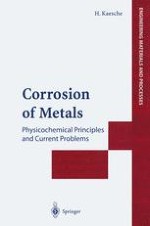2003 | OriginalPaper | Chapter
Corrosion Reactions and Corrosion Products
Author : Prof. em. Dr. rer. nat. Helmut Kaesche
Published in: Corrosion of Metals
Publisher: Springer Berlin Heidelberg
Included in: Professional Book Archive
Activate our intelligent search to find suitable subject content or patents.
Select sections of text to find matching patents with Artificial Intelligence. powered by
Select sections of text to find additional relevant content using AI-assisted search. powered by
To outline corrosion reaction chemistry we turn in the first place to acid corrosion, considering iron in dilute hydrochloric acid solution as a typical example. The reaction equation is (2.1)$$ (\text{Fe})_m + 2(\text{HCl})_l \to (\text{FeCl})_l + (\text{H}_\text{2} )_g , $$ where the subscripts m, l, and g indicate the phases solid metal, liquid aqueous solution, and gas, containing the species solid pure iron, dissolved hydrochloric acid, dissolved ferrous chloride, and gaseous hydrogen, respectively. When components of different phases participate in a reaction, this indexing is useful, but we shall drop it nevertheless whenever possible without danger of confusion, in order to simplify notation. The arrow ‘→’ indicates that the reaction spontaneously proceeds as written from left to right: metallic iron and dissolved hydrochloric acid are the reactants, dissolved ferrous chloride and gaseous hydrogen the products of the overall reaction.
